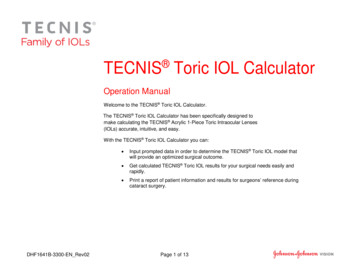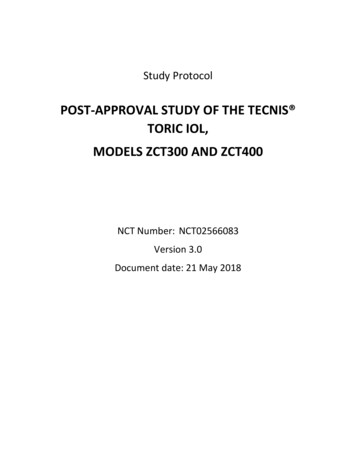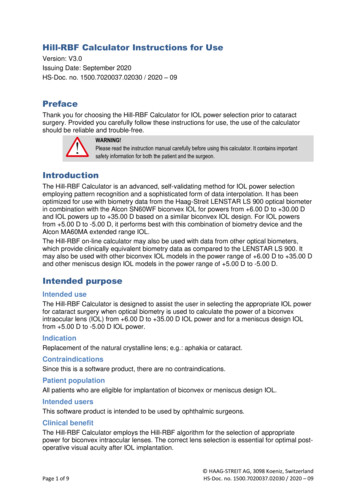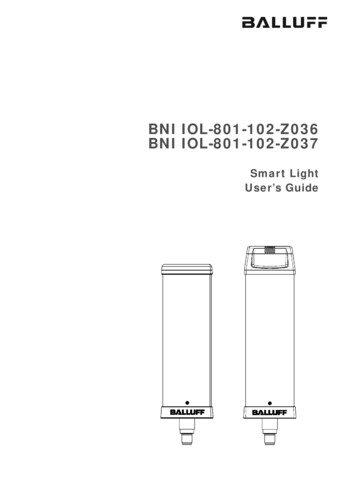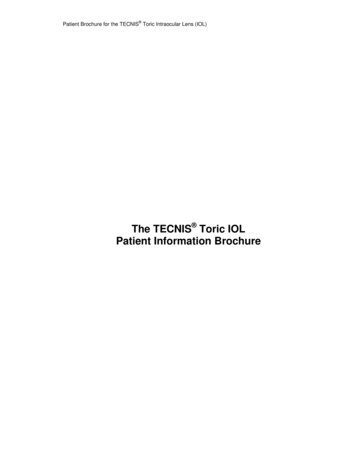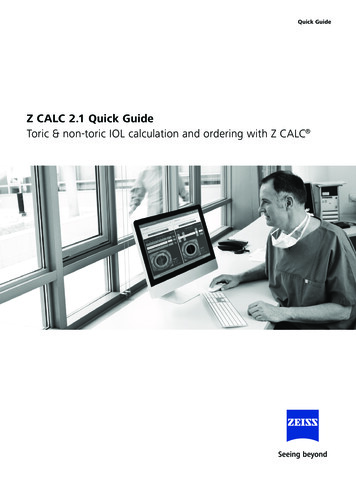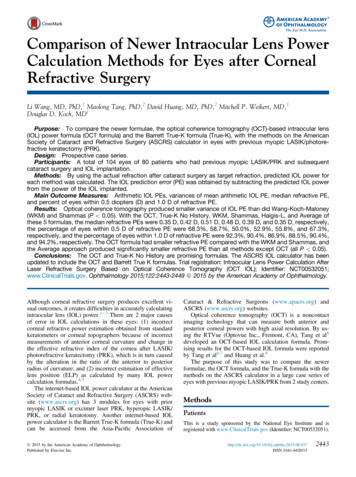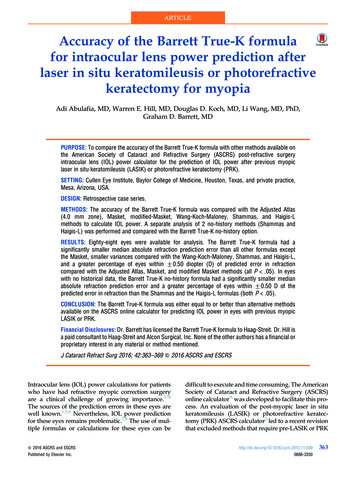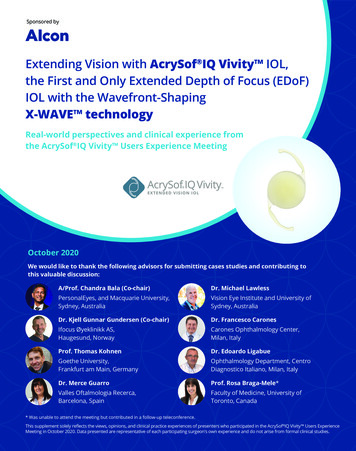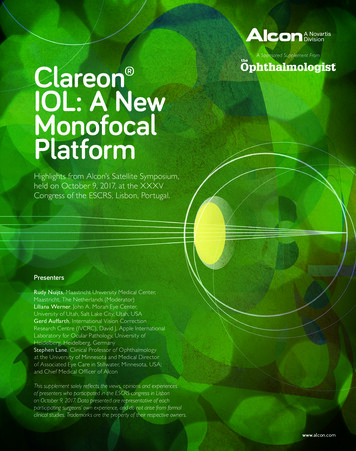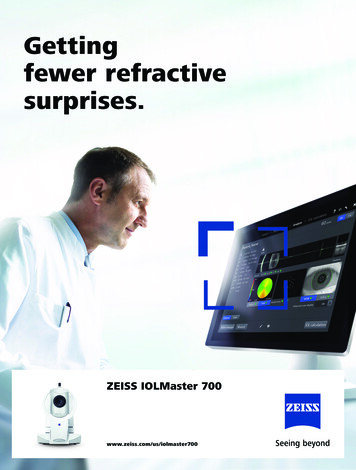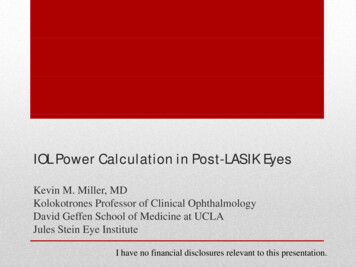
Transcription
IOL PPower CalculationC l l ti ini Post-LASIKP t LASIK EyesEKevin MM. MillerMiller, MDKolokotrones Professor of Clinical OphthalmologyDavid Geffen School of Medicine at UCLAJules Stein Eye InstituteI have no financial disclosures relevant to this presentation.
Consultingg Fee: HOYA SurgicalgOptics;p ; PhysicalyOpticspCorporation Fees for Non-CME Services: SLACK Incorporated Contracted Research: Alcon Laboratories, Inc.; CalhounVisionDisclosures
I would like toacknowledge thecontribution ofRishabh C. Date, aUCLA medicalstudent, to this study.Acknowledgment
To validate the Diehl-Miller equation for achievingemmetropia at the time of cataract surgery in postpost-LASIKLASIKeyes and to present a refined equation. The Diehl-Miller equation relates the manifest refractivesphericalinducedh i l equivalenti l (MRSE)(S ) changehi d d byb LASIKASto an adjusted target postoperative refractive error to beused in IOL ppower calculations.Purpose
TTargett refractivef ti error -0.018(MRSE0 018(MRSE ChChange))2 0.192(MRSE Change) – 0.062MRSE Manifest Refraction Spherical EquivalentDiehl-MillerDiehl Miller PolynomialEquation
Myopic LASIKHyperopic LASIKMRSE ChangeInduced byLASIK (D)TargetRefractive Errorto AchieveEmmetropia (D)MRSE ChangeInduced byLASIK (D)-0.5-0.2 0.50.0-1.0-0.3 1.0 0.1-1.5-0.4 1.5 0.2-2.0-0.5 2.0 0.3-2.5-0.7 2.5 0.3-3.0-0.8 3.0 0.4-3.535-1.010 3 5 3.5 0 4 0.4Look Up TablesTargetRefractive Errorto AchieveEmmetropia (D)
In a regressionanalysis, we expectthe equation to fit thed ffrom whichdatahi h itiwas derived. The issue is how wellit predicts thebehavior of a set ofcompletely new data?The Issue
Preoperative and postoperative refractive and cataractsurgeryg y data were collected from the medical records ofpost-LASIK patients who underwent cataract surgerybetween July 2007 and June 2011. Twenty-three18 patientsTt th eyes fromfti t were evaluated.l t d The Diehl-Miller nomogram was used to targetemmetropiap in all studyy eyes.yMethods
AftAfter cataracttt surgery, IOL power datad t andd postoperativettirefractive information were used to calculate the targetrefractive error that should have been chosen to achieveemmetropia. The polynomial equation produced by the regressionanalysis of these data was compared to the equationobtained in the original analysis. Regressionganalysisy of the combined data from the DiehlMiller study and the current study was used to develop arefined equation, the Diehl-Date-Miller nomogram.Methods
Diehl-Miller: Target refractive error -0.018(MRSEChange)2 0.192(MRSE Change) – 0.062 Date-Miller:D t Mill TargetTt refractivef ti error -0.017(MRSE0 017(MRSEchange)2 0.154(MRSE change) – 0.004g There was no statisticallyy significantdifference betweenthe Diehl-Miller and Date-Miller equations.MRSE Manifest Refraction Spherical EquivalentDiehl-MillerDiehl Miller and Date-MillerDate MillerPolynomial Equations
TTargett refractivef ti error -0.020(MRSE0 020(MRSE change)h)2 0.170(MRSE change) – 0.008MRSE Manifest Refraction Spherical EquivalentDiehl-Date-MillerDiehl Date MillerPolynomial Equation
Myopic LASIKHyperopic LASIKMRSE ChangeInduced byLASIK (D)TargetRefractive Errorto AchieveEmmetropia (D)MRSE ChangeInduced byLASIK (D)-0.5-0.1 0.5 0.1-1.0-0.2 1.0 0.1-1.5-0.3 1.5 0.2-2.0-0.4 2.0 0.3-2.5-0.6 2.5 0.3-3.0-0.7 3.0 0.3-3.535-0.808 3 5 3.5 0 3 0.3Look Up TablesTargetRefractive Errorto AchieveEmmetropia (D)
The Diehl-Miller equation was compared to otherequations available through the ASCRS((www.iolcalc.org).i l l) Based on patient information and measurementequipment available to us, the following methods couldbe evaluated: Masket, Modified-Masket, Shammas,Haigis-L, Clinical History Method, Feiz-Mannis, andB pass Method.MethodCorneal BypassComparison Study
first ever validation of the DiehlDiehl This study constitutes the first-everMiller study. By applying the Diehl-Miller equation prospectively, wewere able to show that it is accurate not only on the patientpopulation from which it was derived, but also on anindependent set of eyes.eyes Thus, Diehl-Miller can be utilized in IOL powercalculations to achieve postoperative emmetropia in postLASIK eyes. The refractive effects of LASIK and PRK are similar, sothe nomogram can probably be used on postPRK eyes.post-PRKeyesDiscussion
By combining the 32 eyes from the Diehl-Miller studywith the 23 eyes from the current Date-Miller study (for at t l off 55 eyes)) we presentt a refinedtotalfi d equation,ti whichhi hrelates the MRSE change induced by LASIK to a targetSE refractive error to be used in IOL power calculations. Associated look up tables are also presented, whicheliminates the need for calculations.Thank You
Jules Stein Eye InstituteJules Stein Eye Institute I have no financial disclosures relevant to this presentation. Consultingggp;yp Fee: HOYA Surgical Optics; Physical Optics Corporation Fees for Non-CME Services: SLACK Incorporated Contracted Research: Alcon Laboratories, Inc.; Calhoun
